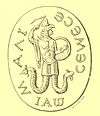Testimony of Truth
This article is about the Gnostic manuscript. For the Quaker testimony to truth/integrity, see Testimony of Integrity.
| Part of a series on | |||
| Gnosticism | |||
|---|---|---|---|
 | |||
| History | |||
| Proto-Gnostics | |||
| Scriptures | |||
|
|||
| Lists | |||
| Related articles | |||
The Testimony of Truth is the third manuscript from Codex IX of the Nag Hammadi Library. The copy of the manuscript from the Nag Hammadi Codices is in very poor condition and is almost too fragmentary to read and comprehend. The text is different from many other Christian texts in that it doesn't portray martyrdom as something to be glorified:
- The foolish, thinking in their heart that if they confess "We are Christians," in word only but not with power, while giving themselves over to a human death, not knowing where they are going or who Christ is, thinking that they will live while they are really in error, hasten toward the principalities and the authorities.
and
- But when they are "perfected" with a (martyr's) death, this is the thought that they have within them: "If we deliver ourselves over to death for the sake of the Name we will be saved." These matters are not settled in this way. But through the agency of the wandering stars they say they have "completed" their futile "course", and [...] say, [...]. But these [...] they have delivered themselves ...
Testimony of Truth, also tells the story of the Garden of Eden from the viewpoint of the serpent. Here the serpent, long known to appear in Gnostic literature as the principle of divine wisdom, convinces Adam and Eve to partake of knowledge while "the Lord" threatens them with death, trying jealously to prevent them from attaining knowledge, and expelling them from Paradise when they achieve it.[1]
Notes and references
External links
- Translation to English by Søren Giversen and Birger A. Pearson
- gnostics.tribe.net excerpt of Testimony of Truth
- June 8, '06 New York Review of Books article The Betrayer's Gospel By Eduard Iricinschi, Lance Jenott, Philippa Townsend
- The Nag Hammadi THE GNOSTIC SOCIETY LIBRARY
- The Nag Hammadi Library
- How the manuscripts were found
This article is issued from Wikipedia - version of the 10/31/2015. The text is available under the Creative Commons Attribution/Share Alike but additional terms may apply for the media files.